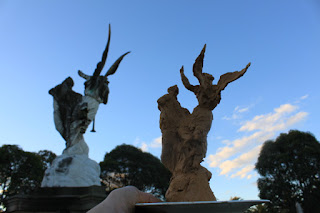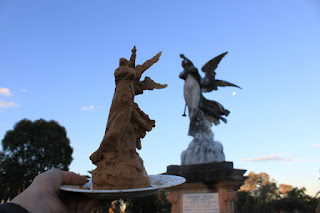This post shows the canvas I have been painting as homage to the Dixson Monument. I am one of seven artists who are participating in an exhibition inspired by the Rookwood Necropolis. The exhibition "Spirited" will be held in the Peacock Gallery, Auburn Botanic Gardens in conjunction with the sculpture exhibition "Hidden" in the grounds of Rookwood itself.
"Spirited" will open on Saturday 18th August 11am - 1pm, and will continue until 30th September. The Peacock Gallery is open from Wed- Sun 11 - 4pm.
.jpg) |
| My oil painting of the Dixson Monument, Rookwood Necropolis $11,000 Enquiries : janecooperbennett@gmail.com |
Whoever they were, they deserve to be famous.
.jpg) | |
| My painting of the Dixson Monument, Rookwood Necropolis $11,000 Enquiries : janecooperbennett@gmail.com |
| The sculpture "Apollo and Daphne" by Bernini in the Galleria Borghese. (Photo credit: Wikipedia) |
A complex swirl of flowing drapery, links the angel to the soul yet separates them.
The arrangement of the 2 figures, entwined yet apart, reminds me of Bernini's "Apollo and Daphne". I have seen this wonderful sculpture in the Borghese Gallery in 1997, but there were so many treasures in this gallery that it was hard to appreciate all of its qualities. I don't know whether the sculptor of the Dixson monument had any knowledge of Bernini or Baroque sculpture but I found strange resonances between the works .
.jpg) |
| My oil painting of the Dixson Monument, Rookwood Necropolis $11,000 Enquiries : janecooperbennett@gmail.com |
Both sculptors used line to force the viewer to move around the sculpture to determine its meaning, sort of like a puzzle. making any one viewpoint incomplete. They both defy cohesion.
Flowing drapery creates large looping rhythms both linking the angel to the soul and separating them..jpg) |
| My oil painting of the Dixson Monument, Rookwood Necropolis |
$11,000
In the "Apollo and Daphne" Flesh turns to bark; Stone into flesh.
In the Dixson monument Stone turns to Flesh; Flesh turns into spirit.The sculptor attempts to capture the sublime.
The
Dixson monument is sacred rather than pagan so it is less overtly
erotic. However the sheer drapery of the rising soul clings to the
gentle curve of her torso with a palpably sensual flourish.
.jpg) |
| My oil painting of the Dixson Monument, Rookwood Necropolis |
.jpg) |
| My oil painting of the Dixson Monument, Rookwood Necropolis |
$11,000
I am painting my view of the Dixon monument 'en plein air', but will keep the influence of Bernini in the back of my mind as I do so.
I
kept noticing details of sculpture that were so very beautiful, where
the feeling was concentrated in a gesture. The skyward pointing finger.
The angel gives a tender glance to the rising soul.
HOLY SONNET VII.
John Donne
At the round earth's imagined corners blow
Your trumpets, angels, and arise, arise
From death, you numberless infinities
Of souls, and to your scattered bodies go ;
All whom the flood did, and fire shall o'erthrow,
All whom war, dea[r]th, age, agues, tyrannies,
Despair, law, chance hath slain, and you, whose eyes
Shall behold God, and never taste death's woe.
But let them sleep, Lord, and me mourn a space ;
For, if above all these my sins abound,
'Tis late to ask abundance of Thy grace,
When we are there. Here on this lowly ground,
Teach me how to repent, for that's as good
As if Thou hadst seal'd my pardon with Thy blood.






















.JPG)
.JPG)



.JPG)
